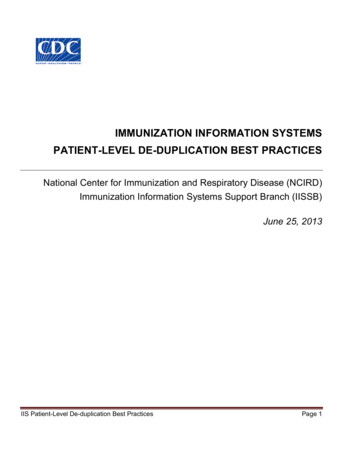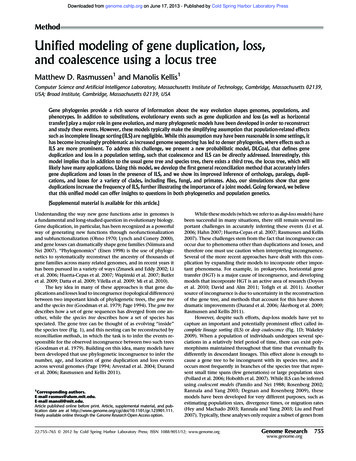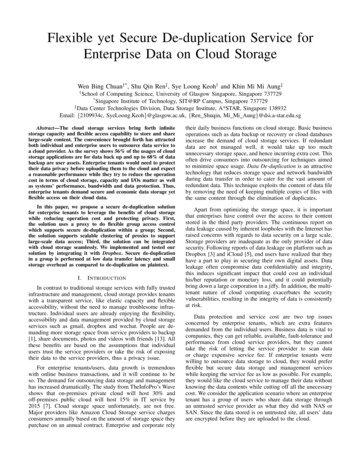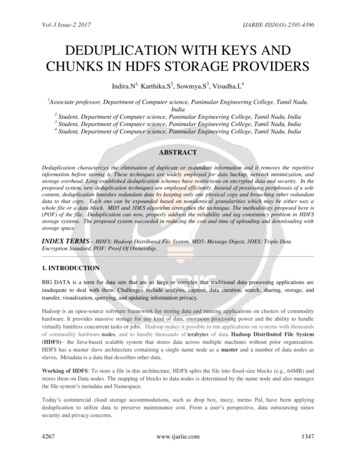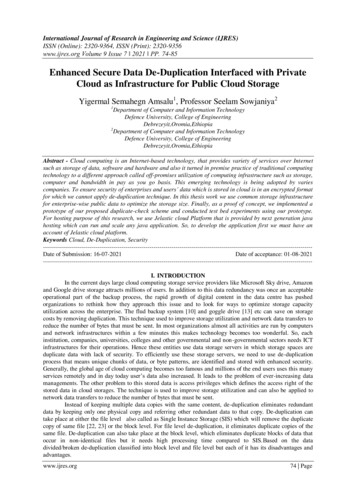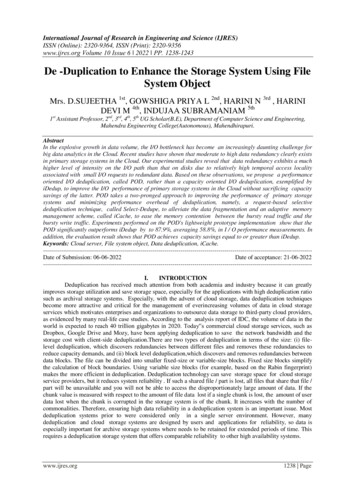
Transcription
International Journal of Research in Engineering and Science (IJRES)ISSN (Online): 2320-9364, ISSN (Print): 2320-9356www.ijres.org Volume 10 Issue 6 ǁ 2022 ǁ PP. 1238-1243De -Duplication to Enhance the Storage System Using FileSystem ObjectMrs. D.SUJEETHA 1st, GOWSHIGA PRIYA L 2nd, HARINI N 3rd , HARINIDEVI M 4th, INDUJAA SUBRAMANIAM 5th1st Assistant Professor, 2nd, 3rd, 4th, 5th UG Scholar(B.E), Department of Computer Science and Engineering,Mahendra Engineering College(Autonomous), Mahendhirapuri.AbstractIn the explosive growth in data volume, the I/O bottleneck has become an increasingly daunting challenge forbig data analytics in the Cloud. Recent studies have shown that moderate to high data redundancy clearly existsin primary storage systems in the Cloud. Our experimental studies reveal that data redundancy exhibits a muchhigher level of intensity on the I/O path than that on disks due to relatively high temporal access localityassociated with small I/O requests to redundant data. Based on these observations, we propose a performanceoriented I/O deduplication, called POD, rather than a capacity oriented I/O deduplication, exemplified byiDedup, to improve the I/O performance of primary storage systems in the Cloud without sacrificing capacitysavings of the latter. POD takes a two-pronged approach to improving the performance of primary storagesystems and minimizing performance overhead of deduplication, namely, a request-based selectivededuplication technique, called Select-Dedupe, to alleviate the data fragmentation and an adaptive memorymanagement scheme, called iCache, to ease the memory contention between the bursty read traffic and thebursty write traffic. Experiments performed on the POD's lightweight prototype implementation show that thePOD significantly outperforms iDedup by to 87.9%, averaging 58.8%, in I / O performance measurements. Inaddition, the evaluation result shows that POD achieves capacity savings equal to or greater than iDedup.Keywords: Cloud server, File system object, Data deduplication, -----------------------------------------Date of Submission: 06-06-2022Date of acceptance: ODUCTIONDeduplication has received much attention from both academia and industry because it can greatlyimproves storage utilization and save storage space, especially for the applications with high deduplication ratiosuch as archival storage systems. Especially, with the advent of cloud storage, data deduplication techniquesbecome more attractive and critical for the management of everincreasing volumes of data in cloud storageservices which motivates enterprises and organizations to outsource data storage to third-party cloud providers,as evidenced by many real-life case studies. According to the analysis report of IDC, the volume of data in theworld is expected to reach 40 trillion gigabytes in 2020. Today‟s commercial cloud storage services, such asDropbox, Google Drive and Mozy, have been applying deduplication to save the network bandwidth and thestorage cost with client-side deduplication.There are two types of deduplication in terms of the size: (i) filelevel deduplication, which discovers redundancies between different files and removes these redundancies toreduce capacity demands, and (ii) block level deduplication,which discovers and removes redundancies betweendata blocks. The file can be divided into smaller fixed-size or variable-size blocks. Fixed size blocks simplifythe calculation of block boundaries. Using variable size blocks (for example, based on the Rabin fingerprint)makes the more efficient in deduplication. Deduplication technology can save storage space for cloud storageservice providers, but it reduces system reliability . If such a shared file / part is lost, all files that share that file /part will be unavailable and you will not be able to access the disproportionately large amount of data. If thechunk value is measured with respect to the amount of file data lost if a single chunk is lost, the amount of userdata lost when the chunk is corrupted in the storage system is of the chunk. It increases with the number ofcommonalities. Therefore, ensuring high data reliability in a deduplication system is an important issue. Mostdeduplication systems prior to were considered only in a single server environment. However, manydeduplication and cloud storage systems are designed by users and applications for reliability, so data isespecially important for archive storage systems where needs to be retained for extended periods of time. Thisrequires a deduplication storage system that offers comparable reliability to other high availability systems.www.ijres.org1238 Page
De -Duplication To Enhance The Storage System Using File System ObjectII. LITERATURE SURVEY1.Similarity and Locality Based Indexing for High Performance Data Deduplication- IEEE Transactionson Computers ( Volume: 64, Issue: 4, April 2015)Data deduplication has gained increasing attention and popularity as a space-efficient approach inbackup storage systems. One of the main challenges for centralized data deduplication is the scalability offingerprint-index search. In this paper, we propose SiLo, a near- exact and scalable deduplication system thateffectively and complementarily exploits similarity and locality of data streams to achieve high duplicateelimination, throughput, and well balanced load at extremely low RAM overhead. The main idea behind SiLo isto expose and exploit more similarity by grouping strongly correlated small files into a segment and segmentinglarge files, and to leverage the locality in the data stream by grouping contiguous segments into blocks tocapture similar and duplicate data missed by the probabilistic similarity detection. SiLo also employs a localitybased stateless routing algorithm to parallelize and distribute data blocks to multiple backup nodes. Byjudiciously enhancing similarity through the exploitation of locality and vice versa, SiLo is able to significantlyreduce RAM usage for index-lookup, achieve the near-exact efficiency of duplicate elimination, maintain a highdeduplication throughput, and obtain load balance among backup nodes.2.Try Managing Your Deduplication Fine-Grained-ly: A Multi-tiered and Dynamic SLA- DrivenDeduplication Framework for Primary Storage -2016 IEEE 9th International Conference on Cloud Computing(CLOUD)Inevitable tradeoff between read performance and space saving always shows up when applyingoffline deduplication for primary storage. We propose Mudder, a multi-tiered and dynamic SLA-drivendeduplication framework to address such challenge. Based on specific Dedup-SLA configurations, Mudderconducts multi-tiered deduplication process combining Global File-level Deduplication (GFD), Local Chunklevel Deduplication (LCD) and Global Chunk-level Deduplication (GCD). More importantly, Mudderdynamically regulates deduplication processes according to instant workload status and predefined Dedup-SLAduring runtime. Data deduplication is an efficient technique used for eliminating redundant data, especiallywhen the growth rate of data has far outpaced the dropping rate in hardware cost. Compared to secondarystorage, primary storage is commonly characterized as “latency-sensitive” for being constantly and directlyaccessed by the end-users. A number of deduplication schemes designed or optimized [1], [2], [3] for primarystorage emerge in recent years. Be that as it may, satisfactory solutions towards some critical challenges havenot been provided by existing deduplication schemes. First, inevitable tradeoff between read performance andspace saving makes it a sophisticated task to apply deduplication for distributed primary storage. Most schemesexecute only one specific type of deduplication, namely, Global File-level Deduplication (GFD) [4], [5], GlobalChunk-level Deduplication (GCD) [6], [7], or Local Chunk-level Deduplication (LCD) [8], [9]. Combinationalschemes that deliver more fine-grained deduplication quality for distributed primary storage have rarely beenresearched. Second, most if not all existing schemes operate in a static mode, executing unchangeddeduplication strategy during runtime regardless of the dynamic nature of primary storage workload. In thispaper, we propose Mudder, a Multi-tiered and dynamic SLA-driven deduplication framework for primarystorage. To begin with, we expand the Dedup-SLA proposed in our previous work [10] by classifying it intotwo types: latency-oriented (Dedup-SLA-L) and space-oriented (DedupSLA-S) Dedup-SLA, according toopposite preferences on performance/space tradeoff. Afterwards, we respectively establish different multitiered deduplication processes for DedupSLAs of both types. We coordinate LCD and GFD for DedupSLA-L tomaintain high read performance with acceptable space saving. We combine GCD and LCD for Dedup-SLAS toeliminate as much redundant data as possible while restricting the impact on read efficiency. Meanwhile,3.HPDV:A Highly Parallel Deduplication Cluster for Virtual Machine Images - 2018 18th IEEE/ACMInternational Symposium on Cluster, Cloud and Grid Computing (CCGRID)Data deduplication has been widely introduced to effectively reduce storage requirement of virtualmachine (VM) images running on VM servers in the virtualized cloud platforms. Nevertheless, the existingstate-of-the-art deduplication for VM images approaches can not sufficiently exploit the potential of underlyinghardware with consideration of the interference of deduplication on the foreground VM services, which couldaffect the quality of VM services. In this paper, we present HPDV, a highly parallel deduplication cluster forVM images, which well utilizes the parallelism to achieve high throughput with minimum interference on theforeground VM services. The main idea behind HPDV is to exploit idle CPU resource of VM servers toparallelize the compute-intensive chunking and fingerprinting, and to parallelize the I/O-intensive fingerprintindexing in the deduplication servers by dividing the globally shared fingerprint index into multipleindependent sub-indexes according to the operating systems of VM images. To ensure the quality of VMservices, a resource-aware scheduler is proposed to dynamically adjust the number of parallel chunking andfingerprinting threads according to the CPU utilization of VM servers. Our evaluation results demonstrate thatwww.ijres.org1239 Page
De -Duplication To Enhance The Storage System Using File System Objectcompared to a state-of-the-art deduplication system for VM images called Light, HPDV achieves up to 67%deduplication throughput improvement.III.EXISTING METHODThe existing data deduplication schemes for primary storage, such as iDedup and Offline-Dedupe, arecapacity oriented in that they focus on storage capacity savings and only select the large requests to deduplicateand bypass all the small requests (e.g., 4KB, 8KB or less). The rationale is that the small I/O requests onlyaccount for a tiny fraction of the storage capacity requirement, making deduplication on them unprofitable andpotentially counterproductive considering the substantial deduplication overhead involved.The existing data deduplication schemes fail to consider these workload characteristics in primarystorage systems, missing the opportunity to address one of the most important issues in primary storage, that ofperformance. Existing scheme focuses on improving the read performance by exploiting and creating multipleduplications on disks to reduce the diskseek delay, but does not optimize the write requests. That is, it uses thedata deduplication technique to detect the redundant content on disks but does not eliminate them on the I/Opath. This allows the disk head to service the read requests by prefetching the nearest blocks from all theredundant data blocks on disk to reduce the seek latency. They only select the large requests to deduplicate andignore all smallrequests (e.g., 4KB, 8KB or less) because the latter only occupy a tiny fraction of the storagecapacity. Moreover, none of the existing studies has considered the problem of space a. Most of them only usean index cache to keep memory, leaving the memory contention problem unsolvedIV PROPOSED SYSTEMTo address the important performance issue of primary storage in the Cloud, and the abovededuplication-induced problems, we propose a Performance-Oriented data Deduplication scheme, called POD,rather than a capacity-oriented one (e.g., iDedup), to improve the I/O performance of primary storage systems inthe Cloud by considering the workload characteristics. POD takes a two-pronged approach to improving theperformance of primary storage systems and minimizing performance overhead of deduplication, namely, arequest-based selective deduplication technique, called Select-Dedupe, to alleviate the data fragmentation andan adaptive memory management scheme, called iCache, to ease the memory contention between the burstyread traffic and the bursty write traffic. More specifically, Select-Dedupe takes the workload characteristics ofsmall-I/O-request domination into the design considerations. It deduplicates all the write requests if their writedata is already stored sequentially on disks, including the small write requests that would otherwise be bypassedfrom by the capacity-oriented deduplication schemes. For other write requests, Select-Dedupe does notdeduplicate their redundant write data to maintain the performance of the subsequent read requests to these data.iCache dynamically adjusts and swaps these data between memory and back-end storage devices accordingly. 6The extensive trace-driven experiments conducted on our lightweight prototype implementation of POD showthat POD significantly outperforms iDedup in the I/O performance measure of primary storage systems withoutsacrificing the space savings of the latter. Moreover, as an application of the POD technology to a backgroundI/O task in primary cloud storage, it is shown to significantly improve the online RAID reconstructionperformance by reducing the user I/O intensity during recovery.Reducing small write traffic:By calculating and comparing the hash values of the incoming small write data, POD is designed to detect andremove a significant amount of redundant write data, thus effectively filtering out small write requests andimproving I/O performance of primary storage systems in the Cloud.Improving cache efficiency :By dynamically adjusting the storage cache space partition between the index cache and the read cache, PODefficiently utilizes the storage cache adapting to the primary storage workload characteristics.Guaranteeing read performance:To avoid the negative readperformance impact of the deduplication-induced read amplification problem, POD isdesigned to judiciously and selectively, instead of blindly, deduplicate write data and effectively utilize thestorage cache.www.ijres.org1240 Page
De -Duplication To Enhance The Storage System Using File System ObjectFig 4.1 Activity Diagram for SenderFig 4.2 Activity Diagram for ReceiverFig 4.3 Use Case Diagramwww.ijres.org1241 Page
De -Duplication To Enhance The Storage System Using File System ObjectV. KEY RESULTSFig 5.1 Welcome PageFig 5.2 Login PageFig 5.3 File Upload and Categorizationwww.ijres.org1242 Page
De -Duplication To Enhance The Storage System Using File System ObjectVI. FUTURE ENHANCEMENTSWe pointed out the potential risks of cross-user source based-deduplication. We described how suchdeduplication can be used as a side channel to reveal information about the contents of files of other users, andas a covert channel by which malicious software can communicate with the outside world, regardless thefirewall settings of the attacked machine. Future work includes a more rigorous analysis of the privacyguarantees provided by our mechanism and a study of alternative solutions that maximize privacy while havingminimal influence on deduplication efficiency. Furthermore, our observations give motivation to an evaluationof the risks induced by other deduplication technologies, and of cross- user technologies in general. The goalmust be to ensure clients that their data remains private, by showing that uploading their data to the cloud has alimited effect on what an adversary may learn about them.VII. CONCLUSIONCloud storage using deduplication techniques and their performance and suggests a variation in theindex of chunk level deduplication and improving backup performance and Reduce the system overhead,improve the data transfer efficiency on cloud is essential so presented approach on application baseddeduplication and indexing scheme that preserved caching which maintains the locality of duplicate content toachieve high hit ratio with the help of the hashing algorithm and improve the cloud backup performance. Thisproposed a novel variation in the deduplication technique and showed that this achieves better [8].[9].[10].M. Armbrust, A. Fox, R. Griffith, A.D. Joseph, R. Katz, A. Konwinski, G. Lee,D. Patterson, A. Rabkin, I. Stoica, and M. Zaharia, „„A View of Cloud Computing,‟‟ Commun. ACM, vol. 53, no. 4, pp. 49-58,Apr. 2010A. Katiyar and J. Weissman, „„ViDeDup: An Application-Aware Framework for Video De-Duplication,‟‟ in Proc. 3rdUSENIXWorkshop Hot-Storage File Syst., 2011, pp. 31-35.D. Bhagwat, K. Eshghi, D.D. Long, and M. Lillibridge, „„Extreme Binning: Scalable, Parallel Deduplication for Chunk BasedFileBackup,‟‟ HP Lab., Palo Alto, CA, USA, Tech. Rep. HPL-2009-10R2, Sept. 2009.K. Eshghi, „„A Framework for Analyzing and Improving Content Based Chunking Algorithms,‟‟ HP Laboratories, Palo Alto,CA,USA, Tech. Rep. HPL- 2005-30 (R.1), 2005.B. Zhu, K. Li, and H. Patterson, „„Avoiding the Disk Bottleneck in the Data Domain Deduplication File System,‟‟ in Proc.6thUSENIX Conf. FAST, Feb. 2008, pp. 269-282.M. Lilli bridge, K. Eshghi, D. Bhagwat, V. Deolalikar, G. Trezise, and P. Camble, „„Sparse Indexing: Large Scale, InlineDeduplication Using Sampling andLocality,‟‟ in Proc. 7th USENIXConf. FAST, 2009, pp. 111-123.P. Anderson and L. Zhang, „„Fast and Secure Laptop Backups With Encrypted De-Duplication,‟‟ in Proc. 24th Int‟l Conf.LISA,2010, pp. 29-40.P. Shilane, M. Huang, G. Wallace, and W. Hsu, „„WAN Optimized Replication of Backup Datasets Using Stream-Informed DeltaCompression,‟‟ in Proc. 10th USENIX Conf. FAST, 2012, pp. 49-64.F. Douglis, D. Bhardwaj, H. Qian, and P. Shilane, „„Content-Aware Load Balancing for Distributed Backup,‟‟ in Proc.25thUSENIX Conf. LISA, Dec. 2011,pp. 151-168.www.ijres.org1243 Page
Dropbox, Google Drive and Mozy, have been applying deduplication to save the network bandwidth and the storage cost with client-side deduplication.There are two types of deduplication in terms of the size: (i) file-level deduplication, which discovers redundancies between different files and removes these redundancies to



